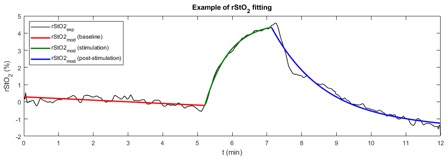Section: New Results
Near-infrared spectroscopy time course under hypercapnia
Participants : Victor Vagné, David Guiraud, Vincent Costalat [CHU Montpellier] , Emmanuelle Le-Bars, Stephane Perrey.
Partial arterial pressure of carbon dioxide (CO2) modulates cerebral blood flow through vasoreactivity mechanism. Near infrared spectroscopy (NIRS) can be used to record these changes in cerebral hemodynamics. However, no laterality comparison of the NIRS signal has been performed despite being a prerequisite for the use of such method in a vasoreactivity monitoring context. We propose to investigate laterality of NIRS signal in response to a CO2-inhalation-based hypercapnia paradigm in healthy volunteers.
Methods: Eleven healthy volunteers (6 women, 5 men, mean age: 31 ± 11) underwent a 3-block-design inhalation paradigm: normoxia (5min, “baseline”) – hypercapnia (2min, “stimulation”) – normoxia (5min, “post-stimulation”). NIRS signal was measured using a two-channel oximeter (INVOS 5100C, Medtronic, USA) with sensors placed symmetrically on both the left and right sides on each subject’s forehead. Additional heart rate (HR) monitoring was performed simultaneously. Based on the NIRS mean signal pattern, an a priori model of parametric identification was applied for each channel to quantify parameters of interest (amplitude, time delay, excitation and relaxation time) for each inhalation block.
Results: HR increased significantly during the stimulation block. The quality of the model was satisfactory: mean absolute error between modeled and experimental signals were lower than the resolution of the device. No significant lateralization were found between left and right values of most of the parameters.
Conclusion: Due to the lack of lateralization, this parametric identification of NIRS responses to hypercapnia could bring light to a potential asymmetry and be used as a biomarker in patients with cerebrovascular diseases.



